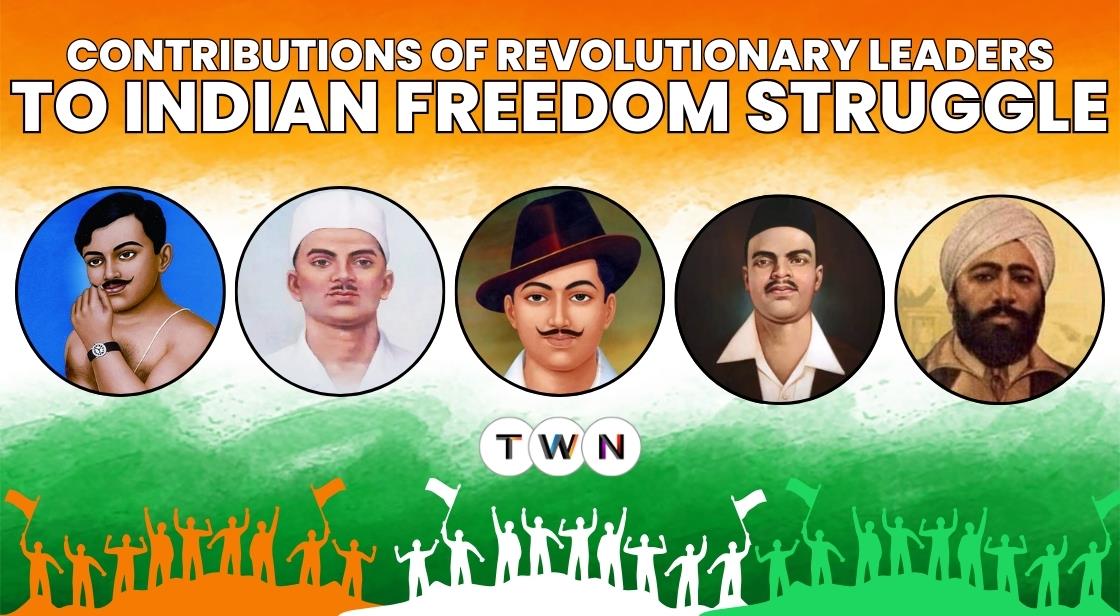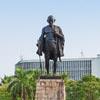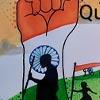Contributions of Revolutionary Leaders to Indian Freedom Struggle

Blog Post
The Indian freedom struggle was a multifaceted and dynamic movement, characterized by diverse strategies and ideologies aimed at overthrowing British colonial rule. Among the various approaches, the revolutionary movements emerged as a particularly radical and impactful force.
These revolutionaries were driven by a profound sense of urgency and disillusionment with the pace of political reform, leading them to adopt more direct and militant tactics to achieve independence.
The early 20th century saw the rise of revolutionary groups and individuals who sought to challenge British authority through acts of defiance and armed resistance.
Figures such as Bal Gangadhar Tilak, Lala Lajpat Rai, Bipin Chandra Pal, Bhagat Singh, and Chandra Shekhar Azad played pivotal roles in this movement, advocating for radical change and inspiring widespread nationalist fervor.
On the occasion of Indian Independence Day 2024, this special blog will delve into the profound contributions of these remarkable revolutionaries. We will explore their pivotal roles, ideologies, and the lasting impact of their actions on India's freedom struggle, shedding light on their enduring legacy and the crucial role they played in shaping our nation's path to independence.
From the revolutionary extremism of the early 1900s to the later movements such as the Quit India Movement and the Naval Mutiny, we will examine how these revolutionary efforts shaped the course of India's path to independence.
#IndependenceDay #IndianFreedomFighters #RevolutionariesOfIndia #FreedomStruggle #TributeToFreedomFighters
#JaiHind #BharatMataKiJai
Role of Revolutionaries in the Indian Freedom Struggle
Revolutionaries in Freedom Struggle
Revolutionaries played a pivotal role in India's freedom struggle, advocating for radical measures to overthrow British colonial rule. Their contributions were marked by passionate activism and significant sacrifices, which influenced the course of the independence movement.
Early Revolutionary Movements
In the early 20th century, discontent with British rule gave rise to various revolutionary groups. These movements aimed at achieving immediate and radical change, contrasting with the more moderate approaches of the time.
Prominent Freedom Fighters of India
Major Revolutionary Leaders
Bal Gangadhar Tilak:
Known as "Lokmanya Tilak," he was a leading figure in the extremist faction of the Indian National Congress. Tilak’s rallying cry, "Swaraj is my birthright, and I shall have it," encapsulated his demand for self-rule. His activism included organizing protests and promoting the Swadeshi movement, which advocated for Indian-made goods.
Lala Lajpat Rai:
A key member of the Lal-Bal-Pal trio, Rai was a staunch advocate of nationalism and social reform. His leadership in the struggle against British policies, including his involvement in the Indian National Congress and his role in the Punjab revolution, marked his significant contributions.
Bipin Chandra Pal:
Alongside Tilak and Rai, Pal was a prominent figure in the extremist camp. His writings and speeches inspired many to join the freedom struggle. Pal’s advocacy for complete independence and his role in various revolutionary activities made him a crucial leader in the movement.
Udham Singh
Known as Shaheed-i-Azam Sardar Udham Singh, he is most famous for his bold act of assassination against Michael O'Dwyer, the former Lieutenant Governor of Punjab. Singh's revolutionary act on March 13, 1940, was driven by a deep-seated desire for revenge.
As a witness to the horrific Jallianwala Bagh Massacre of 1919, Singh sought justice by targeting O'Dwyer, who was perceived as responsible for the tragedy. This act led to Singh's conviction and, subsequently, his execution by hanging in July 1940, administered by the British government.
Bhagat Singh
Bhagat Singh is an iconic figure in the Indian freedom struggle. Renowned for his active participation in various revolutionary movements, Singh's legacy is deeply etched in India's history. At just 23 years old, he was executed by the British authorities, convicted for his role in the assassination of British police officer John Saunders.
Singh's sacrifice and courageous actions left a profound impact on the Indian populace, inspiring many to rally for the nation's freedom and reinforcing the resolve for independence.
Shivaram Rajguru
Shivaram Rajguru was a distinguished member of the Hindustan Socialist Republican Association (HSRA) and a fervent revolutionary dedicated to India's independence. Rajguru, alongside his associates Bhagat Singh and Sukhdev Thapar, played a crucial role in the assassination of John Saunders.
This act was a direct response to the death of Lala Lajpat Rai, who had succumbed to injuries inflicted by police during a protest against the Simon Commission. The assassination of Saunders was intended as retribution for Rai's death, marking Rajguru's commitment to the revolutionary cause.
Sukhdev Thapar
Sukhdev Thapar was an influential member of both the Naujawan Bharat Sabha and the Hindustan Socialist Republican Association. Thapar was instrumental in organizing revolutionary activities in North India and Punjab. Along with Bhagat Singh and Shivaram Rajguru, he participated in the assassination of John Saunders as revenge for the death of Lala Lajpat Rai. Thapar's efforts were crucial in galvanizing revolutionary sentiment and advancing the cause of Indian independence.
Chandra Shekhar Azad
Chandra Shekhar Azad's revolutionary journey began after his disillusionment with the suspension of the Non-Cooperation Movement in 1922. He joined the Hindustan Republican Association, where he became an active member, involved in various revolutionary activities.
Azad's notable actions included robbing government properties to fund the association, the assassination of J.P. Saunders, and the Kakori Train Robbery in 1925. He also attempted to blow up the Viceroy’s train in 1929, further demonstrating his dedication to the revolutionary cause.
Impact on the Freedom Struggle
Revolutionaries like Tilak, Rai, and Pal intensified the struggle for independence through direct action, inspiring subsequent generations. Their efforts laid the groundwork for a more assertive nationalist movement, significantly influencing India's path to freedom.
Also Read: Independence Day 2024: A Journey Through the Evolution of Indian National Flag
Role of Revolutionaries in Indian Freedom Struggle
The Indian freedom struggle was marked by a spectrum of approaches to challenging British colonial rule, from moderate petitions to radical revolutionary activities. Among these, the revolutionary movement played a pivotal role, particularly during the early 20th century.
The revolutionaries, including figures like Bipin Chandra Pal, Lala Lajpat Rai, and Bal Gangadhar Tilak, and organizations such as Anushilan Samiti and Jugantar, exemplified the shift from moderate political reform to more militant forms of resistance.
Emergence of Revolutionary Extremism
The early 20th century witnessed the rise of the Extremist trend within the Indian National Congress (INC), led by prominent leaders like Bipin Chandra Pal, Lala Lajpat Rai, and Bal Gangadhar Tilak. Their frustration with the slow pace of reforms and the lack of significant concessions from the British government led to a more radical approach.
The Swadeshi Movement (1905-1911), which promoted the use of indigenous goods and boycotted British products, became a hallmark of this trend. The movement's aggressive tactics and widespread appeal demonstrated a shift towards direct action as a means of achieving political objectives.
Rise of Revolutionary Terrorism
The dissatisfaction with moderate methods and the perceived ineffectiveness of constitutional methods gave rise to revolutionary terrorism, especially in Bengal and its neighboring regions. Organizations such as the Anushilan Samiti and Jugantar, founded by leaders like Dinesh Gupta, Benoy Basu, Badal Gupta, Khudiram Bose, Prafulla Chaki, and Jatindranath Mukherjee, became central to this movement.
These groups engaged in revolutionary activities, including bombings, assassinations, and other forms of armed resistance, aimed at destabilizing British rule and inspiring widespread revolutionary zeal among Indians.
Impact of Revolutionary Actions
-
Inspiration for Breakaway Factions: The perceived failures of the Moderates in achieving their political goals through petitions and legislative efforts inspired a faction within the INC to adopt more radical methods. The dissatisfaction with the lack of tangible results from moderate approaches prompted some leaders to embrace revolutionary tactics as a more effective means of resistance.
-
Use of Fear Tactics and Active Participation: Revolutionaries employed fear tactics, such as bombings and targeted assassinations, to challenge British authority and draw attention to their cause. Their actions were intended to create an atmosphere of unrest and compel the British government to address Indian grievances more seriously. This direct action approach was a stark contrast to the peaceful protests advocated by the Moderates.
-
Symbols of Sacrifice and National Pride: Revolutionaries like Bhagat Singh, Chandrasekhar Azad, and others became symbols of sacrifice and national pride. Their willingness to endure imprisonment, torture, and execution highlighted their dedication to the cause of independence. Their personal sacrifices and steadfastness inspired many to join the freedom struggle and contributed to a growing sense of national identity and pride.
-
Demonstrating the Need for Active Resistance: The revolutionaries demonstrated that mere petitions and proposals were insufficient for achieving independence. They highlighted the necessity of active demonstrations and direct action in conjunction with political efforts. Their actions underscored the need for a multifaceted approach to the struggle for freedom, combining both political and militant strategies.
Contribution of Revolutionaries in Freedom Struggle of India
The Indian freedom struggle was marked by various strategies employed by different groups to challenge British colonial rule. Among these, the revolutionaries made significant contributions not only through armed resistance but also by fostering a spirit of self-reliance and national pride. Their efforts extended beyond mere political agitation to encompass cultural, educational, and economic reforms, which played a crucial role in advancing the independence movement.
Use of Printing for Pamphlets and Hygiene Manuals
One of the key contributions of revolutionaries was their innovative use of printing technology. Revolutionaries utilized pamphlets and brochures to disseminate their ideas and mobilize public opinion. These printed materials were crucial for spreading nationalist ideas and revolutionary ideology among the masses.
Pamphlets often included information about British atrocities, the importance of independence, and calls to action. Additionally, hygiene manuals were published to educate people on health and sanitation, reflecting a broader concern for improving living conditions as a form of resistance against colonial neglect.
Promotion of Self-Sufficiency and Indigenous Handicraft Industries
Revolutionaries emphasized the importance of self-sufficiency and economic independence as a means to challenge British economic policies. They promoted the use of indigenous handicrafts and traditional industries, which were undermined by British imports.
Leaders like Lala Lajpat Rai and Bal Gangadhar Tilak encouraged the revival of local industries and crafts to reduce reliance on foreign goods and boost national pride. This economic self-reliance was seen as a way to weaken British control and foster a sense of national identity and economic independence.
Establishment of Primary Schools and Colleges
The establishment of educational institutions was another significant contribution of the revolutionaries. They founded numerous primary schools and colleges to provide education that was not only accessible but also aligned with nationalist ideals.
Institutions like the National College in Calcutta founded by Subhas Chandra Bose and the Kumarappa National College in Tamil Nadu played a pivotal role in educating future leaders and fostering a sense of patriotism among students. These educational reforms aimed to produce a generation of educated Indians who could contribute to the independence movement and nation-building.
Military and Professional Training in Weaponry
Understanding the importance of armed struggle, revolutionaries focused on providing military and professional training in weaponry. They established secret training centers where recruits could learn the use of firearms, explosives, and guerrilla tactics.
Organizations like the Hindustan Socialist Republican Association (HSRA) and groups led by Bhagat Singh offered training programs to prepare young revolutionaries for direct action against British authorities. This training was crucial for enhancing the effectiveness of revolutionary activities and maintaining the element of surprise in their operations.
Establishment of Newspapers
The establishment of newspapers was a strategic move by revolutionaries to influence public opinion and spread nationalist ideas. Newspapers such as Bengalee, Bande Mataram, and Amrita Bazar Patrika played a crucial role in reporting on colonial injustices and promoting nationalist sentiments.
These publications provided a platform for revolutionary leaders to voice their opinions, rally support, and criticize British policies. The wide reach of these newspapers helped to create a more informed and politically aware populace, further fueling the independence movement.
The revolutionary movement in India for the freedom struggle
The Indian freedom struggle was characterized by a series of revolutionary movements that aimed to overthrow British colonial rule. Each movement had its own unique motivations, strategies, and outcomes, reflecting the evolving nature of the struggle for independence.
This article explores the key revolutionary movements that defined India's fight for freedom, including the Swadeshi Movement, the Khilafat and Non-Cooperation Movements, the Civil Disobedience Movement, the Quit India Movement, and the Naval Mutiny.
Swadeshi Movement (1905-1911)
The Swadeshi Movement emerged as a direct response to the British decision to partition Bengal in 1905, ostensibly for administrative convenience but widely perceived as a tactic to divide and rule by creating religious discord. Spearheaded by leaders like Bal Gangadhar Tilak, Lala Lajpat Rai, and Bipin Chandra Pal, the movement advocated for the boycott of British goods and the promotion of indigenous industries.
It aimed to foster national unity and self-reliance by encouraging the use of Indian-made products and the establishment of Indian-run enterprises. The Swadeshi Movement galvanized widespread public support and laid the foundation for future nationalist activities, although it faced challenges and eventually declined after the re-unification of Bengal in 1911.
Khilafat Movement/Non-Cooperation Movement (1919-1922)
The Khilafat Movement, led by Maulana Mohammad Ali and Shaukat Ali, was launched in response to the disintegration of the Ottoman Empire and the abolition of the Caliphate after World War I. Indian Muslims sought to protect the Caliphate as a symbol of Islamic unity and leadership. This movement was closely linked with the Non-Cooperation Movement led by Mahatma Gandhi, which sought to challenge British rule through nonviolent means.
Gandhi's call for non-cooperation included boycotting British institutions, resigning from government positions, and refusing to pay taxes. The movement saw mass participation from various sections of Indian society, including Hindus and Muslims, but eventually faltered due to internal differences and the violent incident at Chauri Chaura in 1922, which led Gandhi to suspend the movement.
Civil Disobedience Movement (1930)
The Civil Disobedience Movement was initiated by Mahatma Gandhi with the aim of defying British laws and regulations through peaceful noncompliance. This movement began with Gandhi's famous Salt March, where he and his followers marched 240 miles to the Arabian Sea to produce salt, defying the British monopoly on salt production.
The movement gained widespread support across India and involved various acts of civil disobedience, such as the refusal to pay taxes and the boycott of British goods. The movement highlighted the inherent injustices of British rule and brought international attention to India's quest for independence. Despite facing harsh repression, including mass arrests and brutal crackdowns, the movement significantly mobilized Indian opinion and strengthened the demand for self-rule.
Quit India Movement (1942)
The Quit India Movement, launched by the Indian National Congress under Gandhi's leadership in August 1942, was a decisive and bold call for immediate British withdrawal from India. This movement was triggered by the British government's failure to address Indian demands for independence and its refusal to grant self-rule even after World War II.
The movement called for mass protests, strikes, and civil disobedience, with the slogan "Do or Die." The British response was severe, with widespread arrests and the suppression of dissent. Despite the brutal crackdown, the Quit India Movement marked a significant escalation in the freedom struggle and underscored the Indian population's determination for independence.
Naval Mutiny (1946)
The Naval Mutiny of 1946, also known as the Royal Indian Navy Mutiny, was a critical event in the final phase of the Indian freedom struggle. Triggered by grievances over poor conditions and discriminatory treatment, sailors on the British naval ships in Bombay (now Mumbai) mutinied in February 1946. The mutiny quickly spread to other naval and military units, reflecting widespread discontent among Indian armed forces.
The British government’s inability to effectively handle the mutiny highlighted the weakening of colonial control and the growing urgency for Indian independence. The mutiny was eventually quelled, but it played a significant role in accelerating political negotiations and paved the way for India's eventual independence in 1947.
Garam Dal and Naram Dal Leaders
The Indian National Congress (INC) was founded in 1885 with the aim of providing a unified platform for Indians to express their political aspirations and seek reforms from the British colonial government. Initially, the Congress functioned as a moderate organization, advocating for gradual reforms and greater representation within the existing political framework. The early leaders of the INC were focused on negotiating with the British for incremental changes.
The Split of 1907: Emergence of Extremists and Moderates
By 1907, the Indian National Congress experienced a significant split into two distinct factions, reflecting the divergent strategies and attitudes towards British rule. This split marked a critical turning point in the Indian freedom struggle, as the two factions had differing approaches to achieving independence.
Garam Dal (Extremists)
Overview of Garam Dal
The Garam Dal, or "Hot Faction," emerged as a radical wing within the Indian National Congress in the early 20th century. This faction, characterized by its assertive and militant approach, sought more immediate and substantial reforms compared to its moderate counterparts.
Key Leaders of Garam Dal
-
Bal Gangadhar Tilak: A leading figure who championed the cause of self-rule and believed in direct action against British colonial rule.
-
Lala Lajpat Rai: Known for his strong nationalist sentiments and advocacy for radical methods to achieve independence.
-
Bipinchandra Pal: Another prominent leader who supported the extremist approach and aimed for a more aggressive pursuit of political rights.
Objectives and Strategies of Garam Dal
The Garam Dal advocated for direct action and confrontation with British authorities. It emphasized the need for immediate political and social reforms, and promoted nationalistic fervor through public agitation, protests, and campaigns. Their strategies included the promotion of swadeshi (boycott of British goods) and direct resistance to colonial policies.
Naram Dal (Moderates)
Overview of Naram Dal
The Naram Dal, or "Soft Faction," represented the more moderate wing of the Indian National Congress. This faction preferred a conciliatory approach and sought to achieve political progress through negotiation and gradual reform.
Key Leaders of Naram Dal
-
Gopal Krishna Gokhale: A leading moderate thinker who advocated for incremental reforms and cooperation with the British government.
-
Dadabhai Naoroji: Another prominent moderate leader who worked towards political representation and socio-economic improvements within the British framework.
Objectives and Strategies of Naram Dal
The Naram Dal focused on working within the existing colonial system to secure reforms. They supported constitutional methods, negotiations, and cooperation with the British authorities. This faction was more inclined to accept gradual changes and was involved in assisting the British government during World War I, which further highlighted their moderate stance.
You May Like
EDITOR’S CHOICE












